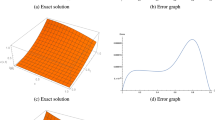Abstract
We compare two approaches to numerically solve the mathematical model of reactive mass transport in porous media with exchange between the mobile fluid and the stationary medium. The first approach, named the “monolithic algorithm,” is the approach in which a standard finite-difference discretization of the governing transport equations yields a single system of equations to be solved at each time step. The second approach, named the “system-splitting algorithm,” is here applied for the first time to the problem of transport with mass exchange. The system-splitting algorithm (SSA) solves two separate systems of equations at each time step: one for transport in the mobile fluid, and one for uptake and reaction in the stationary medium. The two systems are coupled by a boundary condition at the mobile– immobile interface, and are solved iteratively. Because the SSA involves the solution of two smaller systems compared to that of the monolithic algorithm, the computation time may be greatly reduced if the iterative method converges rapidly. Thus, the main objective of this paper is to determine the conditions under which the SSA is superior to the monolithic algorithm (MA) in terms of computation time. We found that the SSA is superior under all the conditions that we tested, typically requiring only 0.3–50% of the computation time required by the MA. The two methods are indistinguishable in terms of accuracy. Further advantages to the SSA are that it employs a modular code that can easily be modified to accommodate different mathematical representations of the physical phenomena (e.g., different models for reaction kinetics within the stationary medium), and that each module of the code can employ a different numerical algorithm to optimize the solution.
Similar content being viewed by others
References
Barry D.A., Miller C.T., Culligan-Hensley P.J. (1996a): Temporal discretisation errors in non-iterative split operator approaches to solving chemical reaction groundwater transport models. J. Contam. Hydrol. 22, 1–17
Barry D.A., Bajracharya K., Miller C.T. (1996b): Alternative split operator approach for solving chemical reaction groundwater transport models. Adv. Water Resour. 19, 261–275
Barry D.A., Miller C.T., Culligan P.J., Bajracharya K. (1997): Analysis of split-operator methods for non-linear and multi-species groundwater chemical transport models. Math. Comput. Simul. 43, 331–341
Barry D.A., Bajracharya K., Crapper M., Prommer H., Cunningham C.J. (2000): Comparison of split-operator methods for solving coupled chemical non-equilibrium reaction/groundwater transport models. Math. Comput. Simul. 53, 113–127
Barry D.A., Prommer H., Miller C.T., Engesgaard P., Brun A., Zheng C. (2002): Modelling the fate of oxidisable organic contaminants in groundwater. Adv. Water Resour. 25, 945–983
Carrayrou J., Mosé R., Behra P. (2004): Operator-splitting procedures for reactive transport and comparison of mass balance errors. J. Contam. Hydrol. 68, 239–268
Chen W., Wagenet R. (1995): Solute transport in porous media with sorption-site heterogeneity. Environ. Sci. Technol. 29, 2725–2734
Chiang C.Y., Dawson C.N., Wheeler M.F. (1991): Modeling of in situ biorestoration of organic compounds in groundwater. Transport Porous Media 6, 667–702
Crittenden J.C., Hutzler N.J., Geyer D.G., Oravitz J.L., Friedman G.(1986): Transport of organic compounds with saturated groundwater flow: model development and parameter sensitivity. Water Resour. Res. 22, 271–284
Cunningham, J.A., Mendoza-Sanchez, I.: Equivalence of two models for biodegradation during contaminant transport in groundwater. Water Resour. Res. 42, W02416 doi:02410.01029/02005WR004205 (2006)
Cunningham J.A., Werth C.J., Reinhard M., Roberts P.V. (1997): Effects of grain-scale mass transport of volatile organics through sediments 1. Model development. Water Resour. Res. 33, 2713–2726
Dykaar B.B., Kitanidis P.K. (1996): Macrotransport of a biologically reacting solute through porous media. Water Resour. Res. 32, 307–320
Haggerty R., Gorelick S.M. (1998): Modeling mass transfer processes in soil columns with pore-scale heterogeneity. Soil Sci. Soc. Am. J. 62, 62–74
Kaluarachchi J.J., Morshed J. (1995): Critical assessment of the operator-splitting technique in solving the advection-dispersion-reaction equation: 1. First-order reaction. Adv. Water Resour. 18, 89–100
Kanney J.F., Miller C.T., Kelley C.T. (2003): Convergence of iterative split-operator approaches for approximating nonlinear reactive transport problems. Adv. Water Resour. 26, 247–261
Karaa S., Zhang J. (2004): High order adi method for solving unsteady convection-diffusion problems. J. Comput. Phys. 198, 1–9
Karki K.C., Patankar S.V. (2004): Application of the partial elimination algorithm for solving the coupled energy equations in porous media. Num. Heat Transfer, Part A. 45, 539–549
Kasten P.R., Lapidus L., Amundson N.R. (1952): Mathematics of adsorption in beds, v, effect of intra- particle diffusion in flow systems in fixed beds. J. Phys. Chem. 56, 683–688
Lanser D., Verwer J.G. (1999): Analysis of operator splitting for advection–diffusion-reaction problems from air pollution modelling. J. Comput. Appl. Math. 111, 201–216
MacQuarrie K.T.B., Sudicky E.A. (2001): Multicomponent simulation of wastewater derived nitrogen and carbon in shallow unconfined aquifers, 1, model formulation and performance. J. Contam. Hydrol. 47, 53–84
Moe W.M., Li C. (2005): A design for activated carbon load equalization system applied to biofilters treating intermittent toluene loading. Chem. Eng. J. 113, 175–185
Peaceman D.W., Rachford H.H. (1955): The numerical solution of parabolic elliptic differential equations. J. Soc. Ind. Appl. Math. 3, 28–41
Pinder G.F., Gray W.G. (1977): Finite Element Simulation in Surface and Subsurface Hydrology, pp 23–25. Academic Press, New York
Roberts P.V., Goltz M.N., Mackay D.M. (1986): A natural gradient experiment on solute transport in a sand aquifer 3 Retardation estimates and mass balances for organic solutes. Water Resour. Res. 22, 2047–2058
Rosen J.B. (1952): Kinetics of a fixed-bed system for solid diffusion into spherical particles. J. Chem. Phys. 20, 2047–2058
Valocchi A.J., Malmstead M. (1992): Accuracy of operator splitting for advection–dispersion-reaction problems. Water Resour. Res. 28, 1471–1476
Villadsen J.V., Stewart W.E. (1967): Solution of boundary-value problems by orthogonal collocation. Chem. Eng. Sci. 22, 1483–1501
Author information
Authors and Affiliations
Corresponding author
Rights and permissions
About this article
Cite this article
Mendoza-Sanchez, I., Cunningham, J. Efficient algorithm for modeling transport in porous media with mass exchange between mobile fluid and reactive stationary media. Transp Porous Med 68, 285–300 (2007). https://doi.org/10.1007/s11242-006-9047-6
Received:
Accepted:
Published:
Issue Date:
DOI: https://doi.org/10.1007/s11242-006-9047-6




